Kenmore 66495113610, 66495113611 Installation Guide

Installation Instructions Instrucciones de instalación Instructions d’installation
English/Español/Français
Kenmore®
Electric Range Estufa eléctrica Cuisinière électrique
P/N W10906475A
Sears Brands Management Corporation
Hoffman Estates, IL 60179 U.S.A.
www.kenmore.com
www.sears.com
Sears Canada Inc.
Toronto, Ontario, Canada M5B 2C3
www.sears.ca
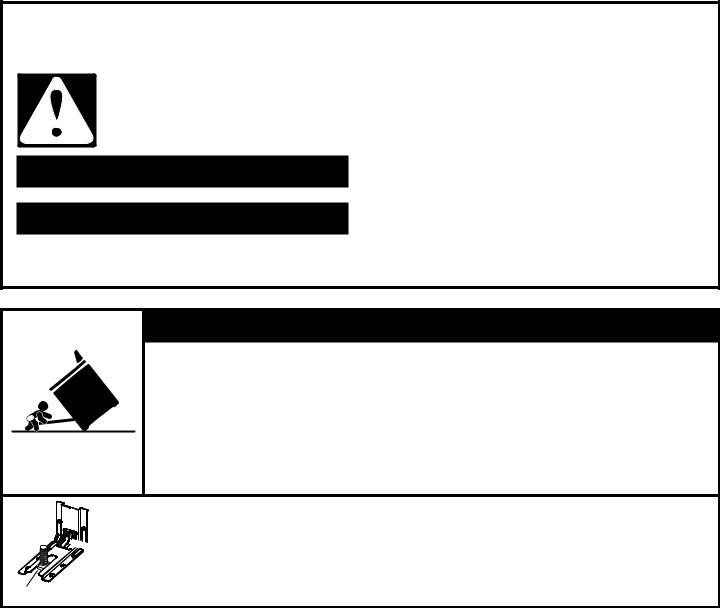
TABLE OF CONTENTS
RANGE SAFETY.................................................................... |
2 |
Install Anti-Tip Bracket.................................................................... |
6 |
INSTALLATION REQUIREMENTS........................................... |
3 |
Adjust Leveling Legs....................................................................... |
7 |
Tools and Parts................................................................................. |
3 |
Level Range...................................................................................... |
8 |
Location Requirements.................................................................... |
3 |
Electrical Connection - U.S.A. Only.............................................. |
8 |
Electrical Requirements - U.S.A. Only.......................................... |
5 |
Verify Anti-Tip Bracket Is Installed and Engaged.................... |
13 |
Electrical Requirements - Canada Only....................................... |
6 |
Remove/Replace Drawer............................................................. |
13 |
INSTALLATION INSTRUCTIONS............................................ |
6 |
Oven Door...................................................................................... |
13 |
Unpack Range.................................................................................. |
6 |
Complete Installation.................................................................... |
14 |
RANGE SAFETY
Your safety and the safety of others are very important.
many important safety messages in this manual and on your appliance. Always read and obey all safety
safety alert symbol.
alerts you to potential hazards that can kill or hurt you and others.
messages will follow the safety alert symbol and either the word “DANGER” or “WARNING.” mean:
 DANGER
DANGER  WARNING
WARNING
You can be killed or seriously injured if you don't immediately follow instructions.
You can be killed or seriously injured if you don't follow instructions.
All safety messages will tell you what the potential hazard is, tell you how to reduce the chance of injury, and tell you what can happen if the instructions are not followed.
 WARNING
WARNING
Tip Over Hazard A child or adult can tip the range and be killed.
Install anti-tip bracket to floor or wall per installation instructions.
Slide range back so rear range foot is engaged in the slot of the anti-tip bracket. Re-engage anti-tip bracket if range is moved.
Do not operate range without anti-tip bracket installed and engaged.
Failure to follow these instructions can result in death or serious burns to children and adults.
Anti-Tip



 Bracket
Bracket
Range Foot
To verify the anti-tip bracket is installed and engaged:
•Slide range forward.
•Look for the anti-tip bracket securely attached to floor or wall.
•Slide range back so rear range foot is under anti-tip bracket.
•See installation instructions for details.
2
INSTALLATION REQUIREMENTS
Tools and Parts
Gather the required tools and parts before starting installation. Read and follow the instructions provided with any tools
listed here.
Tools Needed
■■ Tape measure
■■ Flat-blade screwdriver
■■ Phillips screwdriver ■■ Level
■■ Hand or electric drill ■■ Wrench or pliers
■■ Marker or pencil ■■ Masking tape
■■ 1/4" (6.4 mm) drive ratchet ■■ 1/4" (6.4 mm) nut driver
■■ 3/8" (9.5 mm) and 5/16" (8 mm) nut driver
■■ 1/8" (3.2 mm) drill bit
(for wood floors)
■■ Tin snips or large wire cutters (for cutting ground strap if necessary)
Parts Supplied
Check that all parts are included.
■■ 10-32 hex nuts (attached to terminal block) (3) ■■ Direct wire lugs (3)
■■ #10 x 15/8" (4.1 cm) screws
(for mounting anti-tip bracket) (2)
■■ Anti-tip bracket (inside oven cavity)
Anti-tip bracket must be securely mounted to the back wall or floor. Thickness of flooring may require longer screws
to anchor bracket to subfloor. Longer screws are available from your local hardware store.
Parts Needed
If using a power supply cord kit:
■■ A UL Listed power supply cord kit marked for use with ranges. The cord should be rated at 250 volts minimum,
40 or 50 amps that is marked for use with nominal 13/8" (3.5 cm) diameter connection opening and must end in ring terminals or open-end spade terminals with upturned ends.
■■ A UL Listed strain relief.
Check local codes. Check existing electrical supply. See the appropriate “Electrical Requirements” section.
It is recommended that all electrical connections be made by a licensed, qualified electrical installer.
Location Requirements
IMPORTANT: Observe all governing codes and ordinances.
■■ It is the installer’s responsibility to comply with installation clearances specified on the model/serial/rating plate. The model/serial/rating plate is located behind the oven door on the top right-hand side of the oven frame.
■■ The range should be located for convenient use in the kitchen.
■■ Recessed installations must provide complete enclosure of the sides and rear of the range.
■■ To eliminate the risk of burns or fire by reaching over the heated surface units, cabinet storage space located above the surface units should be avoided. If cabinet storage
is to be provided, the risk can be reduced by installing a range hood or microwave hood combination that projects horizontally a minimum of 5" (12.7 cm) beyond the bottom of the cabinets.
■■ All openings in the wall or floor where range is to be installed must be sealed.
■■ Cabinet opening dimensions that are shown must be used. Given dimensions are minimum clearances.
■■ The anti-tip bracket must be installed. To install the anti-tip bracket shipped with the range, see the “Install Anti-Tip Bracket” section.
■■ Grounded electrical supply is required. See the appropriate “Electrical Requirements” section.
■■ Contact a qualified floor covering installer to check that the floor covering can withstand at least 200°F (93°C).
■■ Use an insulated pad or 1/4" (0.64 cm) plywood under range if installing range over carpeting.
IMPORTANT: To avoid damage to your cabinets, check with your builder or cabinet supplier to make sure that the materials used will not discolor, delaminate, or sustain other damage. This oven has been designed in accordance with the requirements of UL and CSA International and complies with the maximum allowable wood cabinet temperatures of
194°F (90°C).
Mobile Home - Additional Installation Requirements
The installation of this range must conform to the Manufactured Home Construction and Safety Standard, Title
24 CFR, Part 3280 (formerly the Federal Standard for Mobile
Home Construction and Safety, Title 24, HUD Part 280). When such standard is not applicable, use the Standard for
Manufactured Home Installations, ANSI A225.1/NFPA 501A or local codes.
In Canada, the installation of this range must conform with the current standards CAN/CSA - A240 - latest edition or with local codes.
3
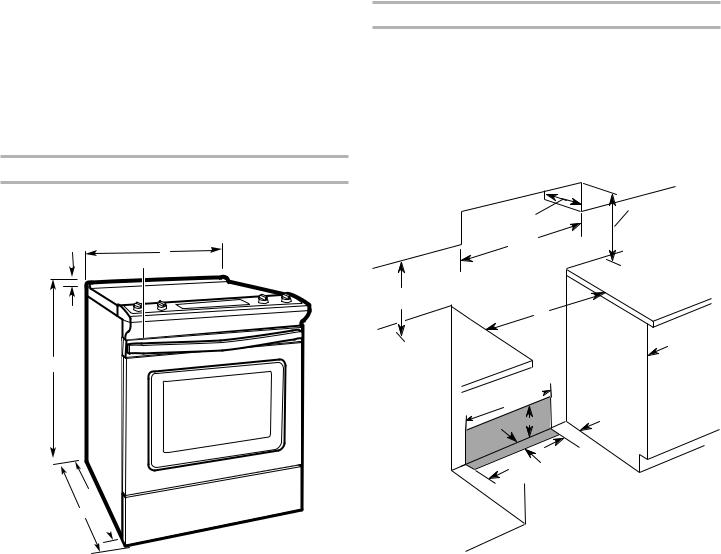
Mobile Home Installations Require:
■■ When this range is installed in a mobile home, it must be secured to the floor during transit. Any method of securing the range is adequate as long as it conforms to the standards listed above.
■■ Four-wire power supply cord or cable must be used in a mobile home installation. The appliance wiring will need to be revised. See the “Electrical Connection - U.S.A. Only” section.
Product Dimensions
This manual covers several models. Your model may appear different from the models depicted. Dimensions given are maximum dimensions across all models.
A B
C
D
E
F 
A. |
13/16" (3.0 cm) height from |
D. 36" (91.4 cm) height to top of |
|
|
cooktop to top of vent |
|
cooktop edge with leveling legs |
B. |
297/8" (75.9 cm) |
|
screwed all the way in* |
C. Model/serial/rating plate |
E. |
2825/64" (72.1 cm) max. depth |
|
|
(located behind the oven door |
|
from front of console to back |
|
on the top right-hand side of |
|
of range |
|
the oven frame) |
F. |
291/64" (73.7 cm) max. depth |
|
|
|
from handle to back of range |
IMPORTANT: Range must be level after installation. Follow the instructions in the “Level Range” section. Using the cooktop as a reference for leveling the range is not recommended.
*Range can be raised approximately 1" (2.5 cm) by adjusting the leveling legs.
Cabinet Dimensions
Cabinet opening dimensions shown are for 25" (64.0 cm) countertop depth, 24" (61.0 cm) base cabinet depth, and
36" (91.4 cm) countertop height.
IMPORTANT: If installing a range hood or microwave hood combination above the range, follow the range hood or microwave hood combination installation instructions for dimensional clearances above the cooktop surface.
Range may be installed next to combustible walls with zero clearance.
D
B
C
A
E
K
G
H I
F 
J
I
A.18" (45.7 cm) upper side cabinet to countertop
B.13" (33 cm) max. upper cabinet depth
C.30" (76.2 cm) min. opening width
D.For minimum clearance to top of cooktop, see NOTE.
E.30" (76.2 cm) min. opening width
F.The shaded area is recommended for installation of grounded outlet.
G.131/8" (33.3 cm)
H.711/16" (19.5 cm)
I.413/16" (12.2 cm)
J.311/16" (9.4 cm)
K.Cabinet door or hinges should not extend into the cutout.
NOTE: 24" (61.0 cm) minimum when bottom of wood or metal cabinet is shielded by not less than 1/4" (0.64 cm) flame retardant millboard covered with not less than No. 28
MSG sheet steel, 0.015" (0.4 mm) stainless steel, 0.024"
(0.6 mm) aluminum, or 0.020" (0.5 mm) copper.
30" (76.2 cm) minimum clearance between the top of the cooking platform and the bottom of an uncovered wood or metal cabinet.
4

Electrical Requirements - U.S.A. Only
If codes permit and a separate ground wire is used, it is recommended that a qualified electrical installer determine that the ground path and wire gauge are in accordance with local codes.
Do not use an extension cord.
Be sure that the electrical connection and wire size are adequate and in conformance with the National Electrical
Code, ANSI/NFPA 70 - latest edition and all local codes and ordinances.
A copy of the above code standards can be obtained from:
National Fire Protection Association
1 Batterymarch Park
Quincy, MA 02169-7471
WARNING: Improper connection of the equipment-grounding conductor can result in a risk of electric shock. Check with a qualified electrician or service technician if you are in doubt as to whether the appliance is properly grounded. Do not modify the power supply cord plug. If it will not fit the outlet, have a proper outlet installed by a qualified electrician.
Electrical Connection
To properly install your range, you must determine the type of electrical connection you will be using and follow the instructions provided for it here.
■■ Range must be connected to the proper electrical voltage and frequency as specified on the model/serial/rating plate. The model/serial/rating plate is located behind the oven door on the top right-hand side of the oven frame.
■■ This range is manufactured with the neutral terminal connected to the cabinet. Use a 3-wire, UL Listed, 40or 50-amp power supply cord (pigtail). See the following Range Rating chart. If local codes do not permit ground through the neutral, use a 4-wire power supply cord rated at 250 volts, 40 or 50 amps and investigated for use with ranges.
Range Rating* |
|
Specified Rating of |
|
|
Power Supply Cord Kit |
|
|
and Circuit Protection |
120/240 Volts |
120/208 Volts |
Amps |
|
|
|
8.8 - 16.5 KW |
7.8 - 12.5 KW |
40 or 50** |
16.6 - 22.5 KW |
12.6 - 18.5 KW |
50 |
*The NEC calculated load is less than the total connected load listed on the model/serial/rating plate.
**If connecting to a 50-amp circuit, use a 50-amp rated cord with kit. For 50-amp rated cord kits, use kits that specify use with a nominal 13/8" (3.5 cm) diameter connection opening.
■■ A circuit breaker is recommended.
■■ The range can be connected directly to the circuit breaker box (or fused disconnect) through flexible or nonmetallic sheathed, copper, or aluminum cable. See the “Electrical Connection - U.S.A. Only” section.
■■ Allow at least 6 ft (1.8 m) of slack in the line so that the range can be moved if servicing is ever necessary.
■■ A UL Listed conduit connector must be provided at each end of the power supply cable (at the range and at the junction box).
■■ Wire sizes and connections must conform with the rating of the range.
■■ The tech sheet and wiring diagram are located on the back of the range in a plastic bag.
If Connecting to a 3-Wire System:
Local codes may permit the use of a UL Listed, 3-wire, 250volt, 40or 50-amp range power supply cord (pigtail). This cord contains 3 copper conductors with ring terminals or open-end spade terminals with upturned ends, terminating in a NEMA Type 10-50P plug on the supply end. Connectors on the appliance end must be provided at the point the power supply cord enters the appliance. This uses a 3-wire receptacle of NEMA Type 10-50R.
3-wire receptacle (10-50R)
If Connecting to a 4-Wire System:
This range is manufactured with the ground connected to the neutral by a link. The ground must be revised so the green ground wire of the 4-wire power supply cord is connected to the cabinet. See the “Electrical Connection - U.S.A. Only” section.
Grounding through the neutral conductor is prohibited for new branch-circuit installations (1996 NEC); mobile homes; and recreational vehicles, or an area where local codes prohibit grounding through the neutral conductor.
When a 4-wire receptacle of NEMA Type 14-50R is used, a matching UL Listed, 4-wire, 250-volt, 40or 50-amp, range power supply cord (pigtail) must be used. This cord contains 4 copper conductors with ring terminals or open-end spade terminals with upturned ends, terminating in a NEMA Type 14-50P plug on the supply end.
The fourth (grounding) conductor must be identified by a green or green/yellow cover and the neutral conductor by a white cover. Cord should be Type SRD or SRDT with a UL Listed strain relief and be at least 4 ft (1.22 m) long.
4-wire receptacle (14-50R)
The minimum conductor sized for the copper 4-wire power cord are:
40-amp circuit
2 No.-8 conductors
1 No.-10 white neutral
1 No.-10 green grounding
5
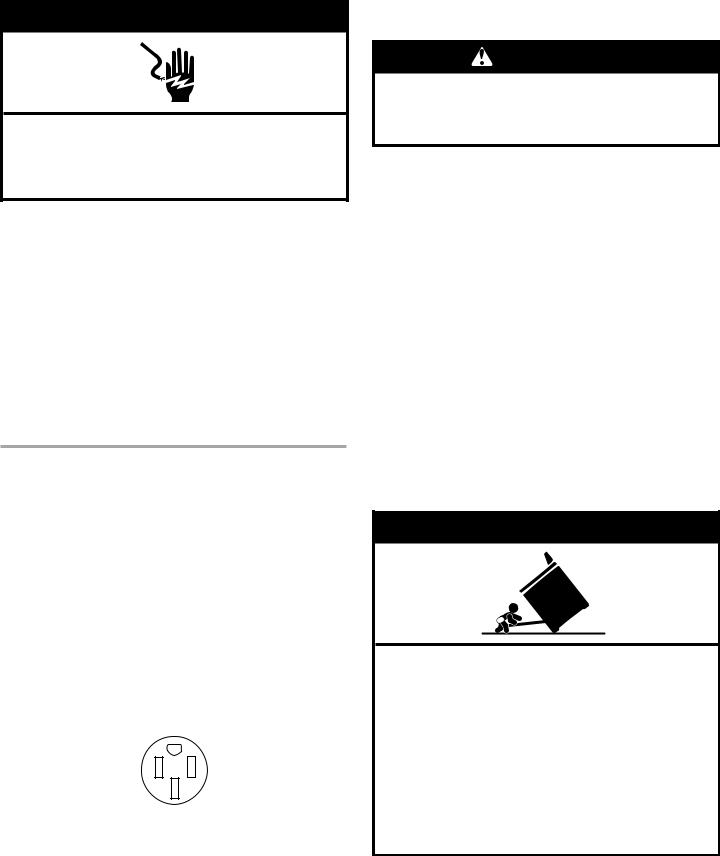
Electrical Requirements - Canada Only
 WARNING
WARNING
Electrical Shock Hazard Electrically ground range.
Failure to do so can result in death, fire, or electrical shock.
If codes permit and a separate ground wire is used, it is recommended that a qualified electrical installer determine that the ground path is adequate and wire gauge are in accordance with local codes.
Be sure that the electrical connection and wire size are adequate and in conformance with CSA Standard C22.1, Canadian Electrical Code, Part 1 - latest edition, and all local codes and ordinances.
A copy of the above code standards can be obtained from: Canadian Standards Association
178 Rexdale Blvd.
Toronto, ON M9W 1R3 CANADA
■■ Check with a qualified electrical installer if you are not sure the range is properly grounded.
Range Rating* |
|
Specified Rating of |
|
|
Power Supply Cord Kit |
|
|
and Circuit Protection |
120/240 Volts |
120/208 Volts |
Amps |
|
|
|
8.8 - 16.5 KW |
7.8 - 12.5 KW |
40 or 50** |
16.6 - 22.5 KW |
12.6 - 18.5 KW |
50 |
*The NEC calculated load is less than the total connected load listed on the model/serial/rating plate.
**If connecting to a 50-amp circuit, use a 50-amp rated cord with kit. For 50-amp rated cord kits, use kits that specify use with a nominal 13/8" (3.5 cm) diameter connection opening.
■■ A circuit breaker is recommended.
■■ This range is equipped with a CSA International Certified
Power Cord intended to be plugged into a standard 14-50R wall receptacle. Be sure the wall receptacle is within reach of range’s final location.
■■ Do not use an extension cord.
■■ The tech sheet and wiring diagram are located on the back of the range in a plastic bag.
INSTALLATION INSTRUCTIONS
Unpack Range
ARNING
Excessive Weight Hazard
Use two or more people to move and install range. Failure to do so can result in back or other injury.
1.Remove shipping materials, tape and film from the range.
Keep cardboard bottom under range. Do not dispose of anything until the installation is complete.
2.Remove oven racks and parts package from oven and shipping materials.
3.To remove cardboard bottom, first take 4 cardboard corners from the carton. Stack one cardboard corner on top of another. Repeat with the other 2 corners. Place them lengthwise on the floor behind the range to support the range when it is laid on its back.
4.Using 2 or more people, firmly grasp the range and gently lay it on its back on the cardboard corners.
5.Remove cardboard bottom.
The leveling legs can be adjusted while the range is on its back. See the “Adjust Leveling Legs” section.
NOTE: To place range back up into a standing position, put a sheet of cardboard or hardboard on the floor in front of range to protect the flooring. Using 2 or more people, stand range back up onto the cardboard or hardboard.
Install Anti-Tip Bracket
 WARNING
WARNING
Tip Over Hazard
A child or adult can tip the range and be killed.
Install anti-tip bracket to floor or wall per installation instructions.
Slide range back so rear range foot is engaged in the slot of the anti-tip bracket.
Re-engage anti-tip bracket if range is moved.
Do not operate range without anti-tip bracket installed and engaged.
Failure to follow these instructions can result in death or serious burns to children and adults.
1. Remove the anti-tip bracket from the inside of the oven.
6

2.Determine which mounting method to use: floor or wall.
If you have a stone or masonry floor, you can use the wall mounting method. If you are installing the range in a mobile home, you must secure the range to the floor.
This anti-tip bracket and screws can be used with wood or metal studs.
3.Determine and mark centerline of the cutout space. The mounting bracket can be installed on either the left-hand or right-hand side of the cutout. Position mounting bracket against the wall in the cutout so that the V-notch of the bracket is 121/2" (31.8 cm) from centerline as shown.
B
Centerline
A
A.121/2" (31.8 cm)
B.Bracket V-notch
4.Drill two 1/8" (3 mm) holes that correspond to the bracket holes of the determined mounting method. See the following illustrations.
Floor Mounting
Rear position |
Front position |
Diagonal (2 options) |
Wall Mounting
5.Using the two #10 x 15/8" (4.1 cm) Phillips-head screws provided, mount anti-tip bracket to the wall or floor.
6.Move range close enough to opening to allow for final electrical connections. Remove shipping base, cardboard, or hardboard from under range.
7.Move range into its final location, making sure rear leveling leg slides into anti-tip bracket.
8.Move range forward onto shipping base, cardboard, or hardboard to continue installing the range, using the following installation instructions.
Adjust Leveling Legs
1.If range height adjustment is necessary, use a wrench or pliers to loosen the 4 leveling legs.
This may be done with the range on its back or with the range supported on 2 legs after the range has been placed back to a standing position.
NOTE: To place range back up into a standing position, put a sheet of cardboard or hardboard in front of range. Using 2 or more people, stand range back up onto the cardboard or hardboard.
 WARNING
WARNING
Tip Over Hazard
A child or adult can tip the range and be killed.
Install anti-tip bracket to floor or wall per installation instructions.
Slide range back so rear range foot is engaged in the slot of the anti-tip bracket.
Re-engage anti-tip bracket if range is moved.
Do not operate range without anti-tip bracket installed and engaged.
Failure to follow these instructions can result in death or serious burns to children and adults.
2.Measure the distance from the top of the counter to the floor.
3.Measure the distance from the top of the cooktop to the bottom of the leveling legs. This distance should be the same. If it is not, adjust the leveling legs to the correct height. The leveling legs can be loosened to add up to a maximum of 1" (2.5 cm). A minimum of 3/16" (5 mm) is needed to engage the anti-tip bracket.
NOTE: If height adjustment is made when range is standing, tilt the range back to adjust the front legs, and then tilt forward to adjust the rear legs.
4.When the range is at the correct height, check that there is adequate clearance under the range for the anti-tip bracket. Before sliding range into its final location, check
that the anti-tip bracket will slide under the range and onto the rear leveling leg prior to anti-tip bracket installation.
NOTE: If a Trim Kit will be used, the top of the cooktop should be higher than the counter. See the Installation Instructions included with the Trim Kit for the correct height.
7
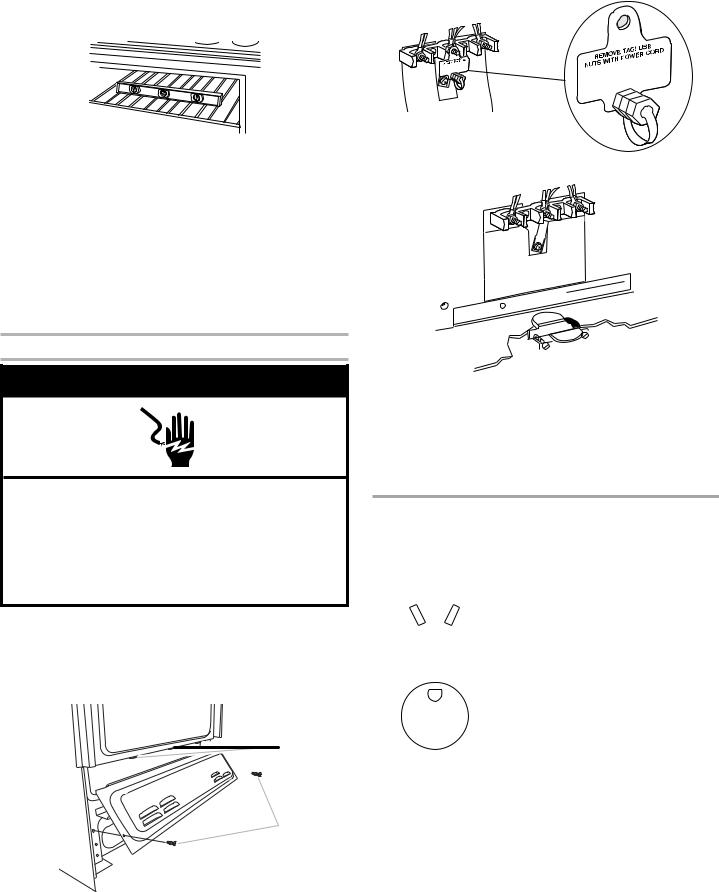
Level Range
1.Place a standard flat rack in oven.
2.Place level on the rack and check levelness of the range, first side to side, then front to back.
3.If range is not level, pull range forward until rear leveling leg is removed from the anti-tip bracket.
4.Use a 1/4" drive ratchet, wrench, or pliers to adjust leveling legs up or down until the range is level. Push range back into position. Check that rear leveling leg is engaged in the anti-tip bracket.
Electrical Connection - U.S.A. Only
If your home has a 3- or 4-wire receptacle, continue with “Install Using a Power Supply Cord.” If your home has a 3- or 4-wire direct connection, go to “Install Using Direct Wire.”
Install Using a Power Supply Cord
 WARNING
WARNING
Electrical Shock Hazard Disconnect power before servicing. Use a new 40 amp power supply cord. Plug into a grounded outlet.
Failure to follow these instructions can result in death, fire, or electrical shock.
Power Supply Cord Strain Relief
1.Disconnect power.
2.Remove the lower access cover screws located on the back of the range. Pull the bottom of the cover toward you and out to remove cover from range.
 A
A

 B
B
C
3.Remove plastic tag holding three 10-32 hex nuts from the middle post of the terminal block.
4. Assemble a UL Listed strain relief in the opening.
 A
A
A.UL Listed strain relief
5.Complete installation following instructions for your type of electrical connection:
4-wire (recommended)
3-wire (if 4-wire is not available)
Electrical Connection Options
If your home has: |
And you will be |
Go to section: |
||||||||
|
|
|
|
|
|
|
|
|
connecting to: |
|
3-wire receptacle |
A UL Listed, |
3-Wire |
||||||||
(NEMA type 10-50R) |
250-volt |
Connection: Power |
||||||||
|
|
|
|
|
|
|
|
|
minimum, |
Supply Cord |
|
|
|
|
|
|
|
|
|
||
|
|
|
|
|
|
|
|
|
40or 50-amp |
|
|
|
|
|
|
|
|
|
|
range power |
|
|
|
|
|
|
|
|
|
|
supply cord |
|
|
|
|
|
|
|
|
|
|
|
|
|
|
|
|
|
|
|
|
|
|
|
4-wire receptacle |
A UL Listed, |
4-Wire |
||||||||
(NEMA type 14-50R) |
250-volt |
Connection: Power |
||||||||
|
|
|
|
|
|
|
|
|
minimum, |
Supply Cord |
|
|
|
|
|
|
|
|
|
40or 50-amp |
|
|
|
|
|
|
|
|
|
|
range power |
|
|
|
|
|
|
|
|
|
|
supply cord |
|
|
|
|
|
|
|
|
|
|
|
|
|
|
|
|
|
|
|
|
|
|
|
A.Mounting tabs (3)
B.Lower access cover
C.Screws (2)
8

3-Wire Connection: Power Supply Cord
Use this method only if local codes permit connecting chassis ground conductor to neutral wire of power supply cord.
1.Feed the power supply cord through the strain relief on the cord/conduit plate on bottom of range. Allow enough slack to easily attach the wiring to the terminal block.
A 




 B
B
C
 D
D
A.Terminal block
B.Ground-link screw
C.UL Listed strain relief
D.Power supply cord wires - large opening
2.Use 3/8" (1.0 cm) nut driver to connect the neutral (white) wire to the center terminal block post with 1 of the 10-32 hex nuts.
A 







 E
E
|
B |
D |
|
|
|
|
C |
|
A. |
10-32 hex nut |
D. Neutral (white) wire |
B. |
Line 2 (red) wire |
E. Line 1 (black) wire |
C.Ground-link screw
3.Connect line 2 (red) and line 1 (black) wires to the outer terminal block posts with 10-32 hex nuts.
4.Firmly tighten hex nuts.
NOTE: For power supply cord replacement, use only a power cord rated at 250 volts minimum, 40 or 50 amps that is marked for use with nominal 13/8" (3.5 cm) diameter connection opening, with ring terminals and marked for use with ranges.
5.Tighten strain relief screws.
IMPORTANT: Verify the tightness of the hex nuts.
6.Replace lower access cover.
4-Wire Connection: Power Supply Cord
Use this method for:
■■ New branch-circuit installations (1996 NEC)
■■ Mobile homes
■■ Recreational vehicles
■■ In an area where local codes prohibit grounding through the neutral
1. Cut out and remove part of metal ground strap, as shown.





 A
A
 B
B
 C
C
A.Metal ground strap
B.Discard
C.Ground-link screw
2.Use a Phillips screwdriver to remove the ground-link screw from the back of the range. Save the ground-link screw and the end of the ground link under the screw.
3.Feed the power supply cord through the strain relief on the cord/conduit plate on bottom of range. Allow enough slack to easily attach the wiring to the terminal block.
A 








 B
B
C
 D
D
A.Terminal block
B.Ground-link screw
C.UL Listed strain relief
D.Power supply cord wires
9
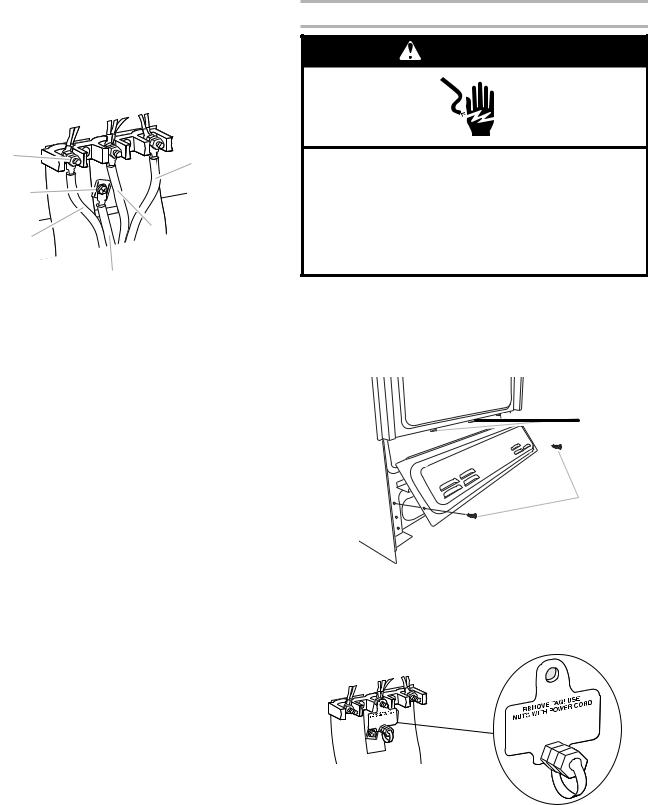
4.Use a Phillips screwdriver to connect the green ground wire from the power supply cord to the range with the groundlink screw and ground-link section. The ground wire must be attached over the ground-link section.
5.Use 3/8" (1.0 cm) nut driver to connect the neutral (white) wire to the center terminal block post with 1 of the 10-32 hex nuts.
|
A |
|
F |
|
|
|
|
|
B |
|
|
|
|
|
E |
|
|
D |
|
A. |
10-32 hex nut |
D. Green ground wire |
|
B. |
Ground-link screw |
E. |
Neutral (white) wire |
C. |
Line 2 (red) wire |
F. |
Line 1 (black) wire |
6.Connect line 2 (red) and line 1 (black) wires to the outer terminal block posts with 10-32 hex nuts.
7.Firmly tighten hex nuts.
NOTE: For power supply cord replacement, use only a power cord rated at 250 volts minimum, 40 or 50 amps that is marked for use with nominal 13/8" (3.5 cm) diameter connection opening, with ring terminals and marked for use with ranges.
8.Tighten strain relief screws.
IMPORTANT: Verify the tightness of the hex nuts.
9.Replace lower access cover.
Install Using Direct Wire
ARNING
Electrical Shock Hazard Disconnect power before servicing.
Use 8 gauge copper or 6 gauge aluminum wire. Electrically ground range.
Failure to follow these instructions can result in death, fire, or electrical shock.
Direct Wire Strain Relief
1.Disconnect power.
2.Remove the lower access cover screws located on the back of the range. Pull the bottom of the cover toward you and out to remove cover from range.
 A
A

 B
B
C
A.Mounting tabs (3)
B.Lower access cover
C.Screws (2)
3.Remove plastic tag holding three 10-32 hex nuts from the middle post of the terminal block.
10
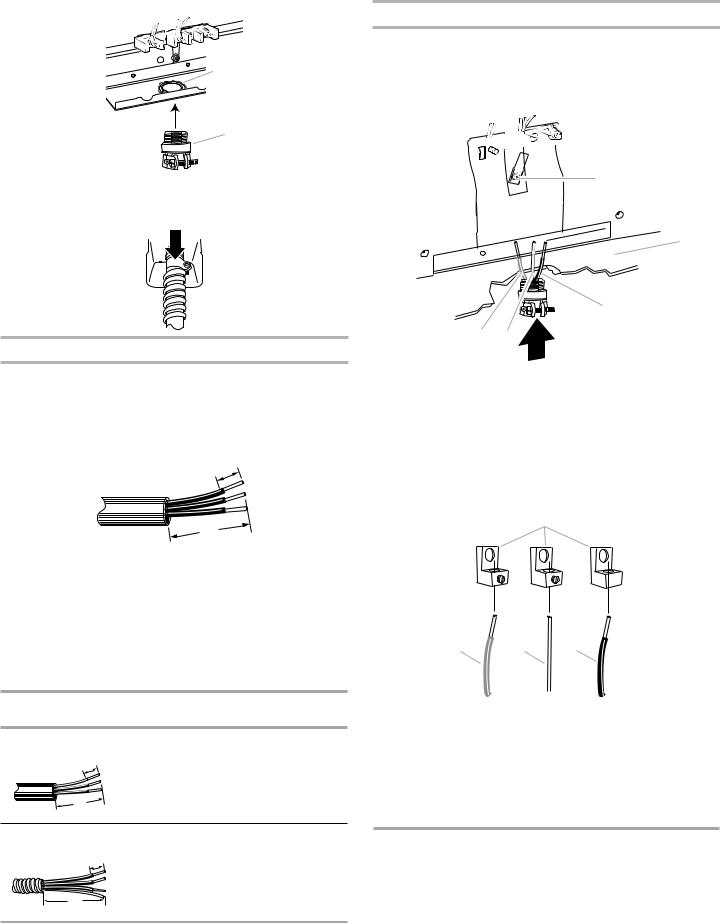
4. Assemble a UL Listed conduit connector in the opening.
A
B
A.Removable retaining nut
B.Conduit
5.Tighten strain relief screw against the flexible conduit.
Direct Wire Installation: Copper or Aluminum Wire
This range may be connected directly to the fuse disconnect or circuit breaker box. Depending on your electrical supply, make the required 3-wire or 4-wire connection.
1.Strip outer covering back 3" (7.6 cm) to expose wires. Strip the insulation back 3/8" (1.0 cm) from the end of each wire.
³⁄ " (1.0 cm)
3" (7.6 cm)
2.Allow enough slack in the wire to easily attach the wiring terminal block.
3.Complete installation following instructions for your type of electrical connection:
4-wire (recommended)
3-wire (if 4-wire is not available)
Electrical Connection Options
If your home has: |
And you will be |
Go to section: |
|
connecting to: |
|
3-wire direct |
A circuit breaker |
3-Wire Connection: |
³⁄ " |
box or fused |
Direct Wire |
(1.0 cm) |
disconnect |
|
|
|
|
3" |
|
|
(7.6 cm) |
|
|
4-wire direct |
A circuit breaker |
4-Wire Connection: |
³⁄ " |
box or fused |
Direct Wire |
(1.0 cm) |
disconnect |
|
|
|
|
5" |
|
|
(12.7 cm) |
|
|
3-Wire Connection: Direct Wire
Use this method only if local codes permit connecting ground conductor to neutral supply wire.
1.Pull the wires through the conduit on cord/conduit plate on bottom of range. Allow enough slack to easily attach the wiring to the terminal block.
A 







|
|
|
|
B |
|
|
|
|
C |
|
|
|
|
F |
|
D |
E |
|
|
A. Terminal block |
|
D. Line 2 (red) wire |
||
B. |
Ground-link screw |
E. |
Bare (green) ground wire |
|
C. |
Cord/conduit plate |
F. |
Line 1 (black) wire |
|
2.Attach terminal lugs to line 2 (red), bare (green) ground, and line 1 (black) wires. Loosen (do not remove) the setscrew on the front of the terminal lug and insert exposed wire end through bottom of terminal lugs. Securely tighten setscrew to torque as shown in the following Bare Wire
Torque Specifications chart.
A


 B
B
C D E
A.Terminal lug
B.Setscrew
C.Line 2 (red) wire
D.Bare (green) ground wire
E.Line 1 (black) wire
Bare Wire Torque Specifications
Attaching terminal lugs to the terminal block - 20 lbs-in.
(2.3 N-m)
Wire Awg |
Torque |
|
|
8 gauge copper |
25 lbs-in. (2.8 N-m) |
|
|
6 gauge aluminum |
35 lbs-in. (4.0 N-m) |
11

3.Use 3/8" (1.0 cm) nut driver to connect the bare (green) ground wire to the center terminal block post with 1 of the 10-32 hex nuts.
F
A 

E
B
|
|
C |
D |
|
|
|
|
A. |
10-32 hex nut |
D. Bare (green) ground wire |
|
B. |
Line 2 (red) wire |
E. |
Line 1 (black) wire |
C. |
Ground-link screw |
F. |
Terminal lug |
4.Connect line 2 (red) and line 1 (black) wires to the outer terminal block posts with 10-32 hex nuts.
5.Firmly tighten hex nuts.
IMPORTANT: Verify the tightness of the hex nuts.
6.Replace lower access cover.
4-Wire Connection: Direct Wire
Use this method for:
■■ New branch-circuit installations (1996 NEC)
■■ Mobile homes
■■ Recreational vehicles
■■ In an area where local codes prohibit grounding through the neutral
1. Cut out and remove part of metal ground strap, as shown.





 A
A
 B
B

 C
C
A.Metal ground strap
B.Discard
C.Ground-link screw
2.Use a Phillips screwdriver to remove the ground-link screw from the back of the range. Save the ground-link screw and the end of the ground link under the screw.
3.Pull the wires through the strain relief on bottom of range. Allow enough slack to easily attach wiring to the terminal block.
A 







|
|
|
B |
|
|
|
C |
D |
|
|
G |
|
|
|
|
E |
F |
|
|
|
|
|
|
A. Terminal block |
|
E. |
Line 2 (red) wire |
B. Ground-link screw |
F. |
Neutral (white) wire |
|
C. Cord/conduit plate |
G. Line 1 (black) wire |
||
D. Bare (green) ground wire |
|
|
|
12
